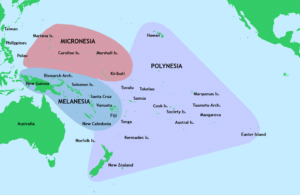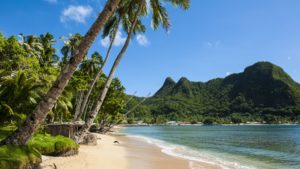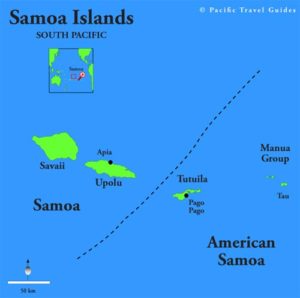» posted on Friday, July 15th, 2022 by Linda Lou Burton
One Samoa Two Samoa
Originally Published July 18, 2020 by Linda Lou Burton posting about the Samoan Islands from Little Rock, Arkansas – Divide the thousands of islands in the Pacific Ocean into three major cultural areas – Micronesia, Melanesia, and Polynesia. Now let’s hone in on one, the part of my planned RTW journey – Polynesia. What is Polynesia, anyhow? Geologically speaking, it is more than a thousand islands in the mid and southern part of the Pacific. Most Polynesian islands and archipelagos, including the Hawaiian and Samoan islands, are volcanic, built by hotspots (remember our Hot Spot post of July 15). But some are the unsubmerged portions of a largely sunken continent. New Zealand, the largest island in Polynesia, is one of those.
 Culturally, these Polynesian islands share similarities in language and belief systems, and not surprisingly, a strong tradition of sailing. Politically, they differ widely. Within the core island groups, there are countries, collectivities, dependencies, self-governing states, a US state, four territories and four independent nations! My RTW was to include stops in the US state of Hawaii, the US territory of American Samoa, and the independent nations of Samoa, and New Zealand.
Culturally, these Polynesian islands share similarities in language and belief systems, and not surprisingly, a strong tradition of sailing. Politically, they differ widely. Within the core island groups, there are countries, collectivities, dependencies, self-governing states, a US state, four territories and four independent nations! My RTW was to include stops in the US state of Hawaii, the US territory of American Samoa, and the independent nations of Samoa, and New Zealand.
Today’s focus: American Samoa and Samoa
American Samoa
- Capital: Pago Pago
- Land Area: 77 sq miles
- Population: 55,212
- Currency: US Dollar
- Language: English, Samoan
- Religion: 98% Christian
- Airport: Pago Pago International, service to Honolulu, inter-island
Samoa
- Capital: Apia
- Land Area: 1,097 sq miles
- Population: 195,843
- Currency: Tala
- Language: Samoan, English
- Religion: Christian Official
- Airport: Faleolo International Airport, service to Australia, New Zealand, Honolulu, inter-island
 American Samoa, capital city Pago Pago, has been a US territory since 1900 and the end of the Second Samoan Civil War, when the Samoan Islands were divided. For 51 years the US Navy controlled the territory. Today American Samoa is locally self-governing under a 1967 constitution. In 1977 the first governor was elected; in 1981 the first non-voting member of Congress. People born in American Samoa are US nationals, but not citizens. It is the only US Territory where citizenship is not granted automatically at birth.
American Samoa, capital city Pago Pago, has been a US territory since 1900 and the end of the Second Samoan Civil War, when the Samoan Islands were divided. For 51 years the US Navy controlled the territory. Today American Samoa is locally self-governing under a 1967 constitution. In 1977 the first governor was elected; in 1981 the first non-voting member of Congress. People born in American Samoa are US nationals, but not citizens. It is the only US Territory where citizenship is not granted automatically at birth.
 Samoa, capital city Apia, is a unitary parliamentary democracy, and a member of the Commonwealth of Nations and the United Nations. It was governed by New Zealand until its independence in 1962, and was the first small-island country in the Pacific to become independent.
Samoa, capital city Apia, is a unitary parliamentary democracy, and a member of the Commonwealth of Nations and the United Nations. It was governed by New Zealand until its independence in 1962, and was the first small-island country in the Pacific to become independent.
As a people, Samoans share a common language, a warm, generous spirit, and a 3,000-year-old cultural code. Fa’a Samoa, the Samoan Way, emphasizes loyalty to family, respect for one’s elders, and a commitment to serving the community, which is considered all-important. But even though the capital cities of Pago Pago and Apia are only 123 miles apart, and the landscapes share the same gorgeous tropical blues and greens, the two Samoas have gradually shifted their connections towards different sides of the Pacific.
In 2009, the Samoan government changed the rule of the road from right to left, in common with Australia and New Zealand, home to large numbers of Samoans. In 2011, Samoa further connected to those countries by moving the International Dateline. At the end of December that year, it simply jumped forward one day. Instead of being 21 hours behind Sydney, now it is three hours ahead, allowing for easier business connections with Australia and New Zealand. American Samoa’s business connections are more closely tied to Hawaii, and the US mainland, and the impact of US culture is evident there.
 The dateline change means Samoan nationals no longer share the same day with their friends and families in American Samoa. But they can share Christmas dinner on two separate Christmas days! Because of that dateline draw, American Samoa is where a day officially ENDS, and Samoa where a day officially BEGINS.
The dateline change means Samoan nationals no longer share the same day with their friends and families in American Samoa. But they can share Christmas dinner on two separate Christmas days! Because of that dateline draw, American Samoa is where a day officially ENDS, and Samoa where a day officially BEGINS.
More about that in tomorrow’s post, when I would actually LOSE a day of my life!
